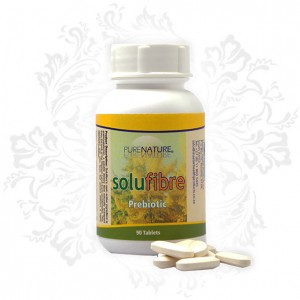What are Prebiotics?
Prebiotics and probiotics help our digestive system work efficiently thereby maintaining our overall health and well-being.
The Digestive system
The digestive system breaks down the food we consume and helps with the absorption of the nutrients that our bodies need to maintain health and energy. It comprises the digestive tract and various other
organs such as the liver, pancreas and gall bladder.
The digestive tract is a system of linked organs, starting with the mouth and ending with the anus. The organs that make up the digestive tract are the mouth, oesophagus, stomach, small and large intestine (also known as the colon), rectum and anus. The food is moved through the system by peristalsis –the process of the smooth muscles contracting, mixing and pushing the food forwards. The liver and the pancreas produce digestive juices, which assist in breaking down the food and the nervous and circulatory systems aid in the absorption and distribution of the nutrients to the rest of the body.
Digestion starts in the mouth as the teeth grind the food into smaller pieces and it is then mixed with saliva, which contains an enzyme called amylase that digests the starch, producing smaller molecules. Once the food is in manageable sizes, it is swallowed and pushed into the oesophagus, which connects the throat with the stomach. The stomach has three main functions:
- It stores food and liquid that enter it from the oesophagus
- It mixes the food, liquid and digestive juices produced by the
stomach thereby continuing the digestive process - It propels the food into the small intestine for further digestion
The time that different foods remain in the stomach varies. For example, fats remain longest and carbohydrates the shortest. The stomach’s digestive juices produce stomach acid and an enzyme that digests protein. The mucosa (a mucus-secreting membrane lining the stomach) is covered with a thick layer of mucus which prevents the acid from digesting the stomach tissue.
Once chyme (the thick semi-fluid mass of partly digested food produced by the stomach) enters the small intestine, the liver produces bile, which dissolves the fat in food allowing the enzymes of the pancreas and intestinal lining to digest it. The pancreas secretes a wide array of enzymes, which also breaks down the carbohydrates and protein. Most of the digested food, water and minerals are absorbed through the intestinal walls and transported by the bloodstream to the rest of the body for storage or further change.
The waste products, such as liquefied undigested food and fibre, are delivered to the colon. The first part of the colon’s function is to remove water from the undigested matter and the second part, produces mucus which binds and lubricates the solid waste so that it can easily be excreted. The colon is made up of four parts:
- the ascending colon – located on the right side of the abdomen and extending upward
- the transverse colon – going from the right side to the left side where it joins the next section. Its function is to absorb fluids and salts
- the descending colon – which goes down the left side until it reaches the sigmoid colon. It holds the resulting waste until the nervous system instructs the body to expel the faeces.
- The Sigmoid colon joins the rectum, which also holds the resulting waste until such time that the anus passes the stool from the body.
About 400 varieties of microflora or bacteria (including acidophilus and bacillus coli) coat the small intestine and colon. These are vital in aiding digestion, promoting essential nutrient production such as vitamin K and some components of the vitamin B complex, maintaining the pH levels, synthesising folic acid and preventing the proliferation of harmful bacteria.
Just as people of differing cultures learn to live in an almost symbiotic community ambiance, so in a healthy digestive system, bacteria and yeast organisms live in harmony in a win-win environment. But, just as a “rotten apple” upsets cultural peace, when a digestive imbalance occurs due to a lifestyle change, inadequate eating habits, harmful environmental factors or damaging medication (particularly antibiotics), beneficial organisms reduce, allowing infective organisms to flourish. Antibiotics, like soldiers running amok, kill off both healthy and pathogenic bacteria – in other words, we have a “gut full” of them.
But, there is a solution.
Used in tandem, probiotics and prebiotics (the before and after help for the lower colon) maintain and restore a healthy micro-environment within the digestive tract.
The difference between probiotics and prebiotics?
Probiotics are the good guys – microflora or good bacteria attached to your colon wall. They help the gut to maintain a healthy and balanced inner ecosystem. The word probiotics – from the Greek words ‘for life’ – was coined by Lilly and Stillwell in 1965. The most common probiotics include the Lactobacillis and Bifidobacterium families of bacteria.
On the other hand, the study of prebiotics (the prefix ‘pre’ meaning ‘before’) is a much younger field. Professor Gibson and Dr Roberfroid “found” the term only in 1995. They defined them as “a non-digestible food ingredient which helps a host by selectively stimulating growth and/or activity of useful bacteria in the colon”, i.e. they feed the probiotics.
A prebiotic is a non-digestible carbohydrate or fibre, which feeds and stimulates the healthy bacteria or microflora in the gut, ensuring their and your survival, health and growth. Research indicates they also suppress the growth of ‘bad’ bacteria such as E coli.
Why Prebiotics can be more beneficial than Probiotics.
Unlike probiotic bacteria, prebiotic carbohydrates are unsusceptible to gastric juices and digestive enzymes and therefore their numbers are not diminished as they move through the digestive tract. They selectively stimulate growth and the activity of useful bacteria in the colon.
Probiotics, on the other hand, are digestible and susceptible to gastric juices and digestive enzymes. This severely diminishes their numbers en route, although they move through the digestive tract in spore form, which makes them more resilient. Current feeling supports the idea that it is more beneficial to provide the lower intestine with prebiotics to feed and grow the natural probiotics, than to try to introduce additional microflora from an external source.
According to Professor Glenn Gibson of Reading University: “Because you have more chances of getting prebiotics to the large intestine, you see a bigger response than you would possibly expect with a probiotic”.
In general, prebiotics and probiotics are important for the following reasons. They can be used to:
- Prevent the growth of harmful bacteria
- Manage lactose intolerance
- Aid in lowering cholesterol
- Moderately lower blood pressure
- Enhance the immune function
- Reduce inflammation
- Improve mineral absorption
- Help in preventing diarrhea
- Prevent IBS (Irritable bowel syndrome), Candida, Crohn’s disease, Hayfever and constipation, gastroenteritis
- Stop bladder infections
Prebiotics have the additional benefits of:
- Increasing the body’s calcium uptake
- Aiding in the management of diabetes
- Enhancing metabolic activity
- Promoting better bone health
- Reducing the prevalence of allergic symptoms such as atopic eczema.
- Assisting in preventing colon cancer





